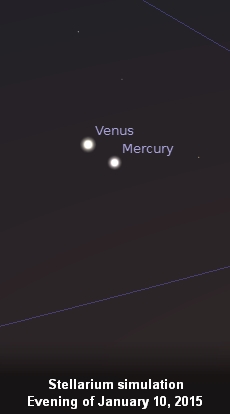¡SkyCaramba! Weekly astronomy blog for the week ending January 10, 2015
A casual definition of conjunction says it’s when two planets appear to be closest together in our sky. But the professional definition that astronomers use says one object must be due north of the other. They aren’t necessarily closest together at that time. And they may also appear very close together without being in conjunction. Mercury and Venus provide an excellent example for us this month.
 Any line going from the north celestial pole to the south celestial pole is called a line of right ascension. Right ascension is measured all the way around the celestial sphere either in degrees from 0 to 360 or in hours from 0 to 24. Degrees and hours are each divided into minutes and seconds. However, they are identical in name and not in measure. When two planets are on the same line of right ascension, they are in conjunction in right ascension.
Any line going from the north celestial pole to the south celestial pole is called a line of right ascension. Right ascension is measured all the way around the celestial sphere either in degrees from 0 to 360 or in hours from 0 to 24. Degrees and hours are each divided into minutes and seconds. However, they are identical in name and not in measure. When two planets are on the same line of right ascension, they are in conjunction in right ascension.
Some astronomers don’t like to acknowledge conjunctions in right ascension. Using that system of marking the sky, all lines of right ascension cross the celestial equator half way from celestial pole to celestial pole. But for thousands of years, observers have recognized that the planets stray from the celestial equator. They follow another line called the ecliptic. Lines perpendicular to the ecliptic are called lines of celestial longitude. And for much of history, planets were said to be in conjunction with each other when one was north or south of the other on a line of celestial longitude.
Whichever is your preference, the moment of conjunction is not necessarily when two planets appear closest to each other. If both happen to be moving parallel to the celestial equator when they are at the same right ascension, conjunction in right ascension will be the time when they are closest. Likewise, if both happen to be moving parallel to the ecliptic, they can be closest to each other at the moment of conjunction in celestial longitude. Usually, any two planets going through conjunction in either way will appear closest a little before or after.
It just so happens that once in a while, two planets may become very close to each other in our sky without being on a north-south line in either method of marking the sky. Mercury and Venus are 0.6° from each other on January 11th at 01:00 Universal Time. But their apparent motion is such that they never attain the same right ascension or celestial longitude before pulling apart. So even though they’ll be barely the width of the full moon from each other, you shouldn’t be surprised to find this close call omitted from planetary conjunction lists.
When the distance two objects have between them in the sky is represented in degrees, it is called their angular separation. And so, at SkyCaramba, such a close call is called a conjunction in angular separation. Whether anybody else recognizes it as a conjunction is a function of how they define it.
Whatever you want to call it, you can see Mercury somewhat easily this month, thanks to minimal separation from Venus. Look for bright Venus in the west just after sunset. Mercury will be right below it and getting closer from night to night until the 10th or 11th when you will see the two closest together. Venus is easy to see with the unaided eyd. Using binoculars may help with Mercury if there’s still some twilight or light from other sources near the horizon.
¡SkyCaramba!